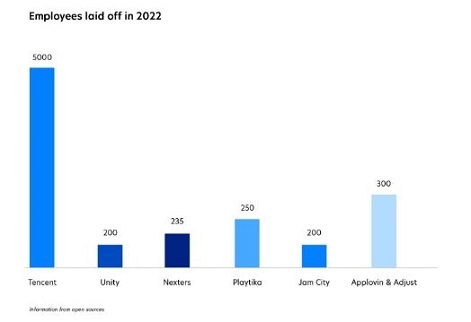With the cost of living rising worldwide and the mobile market normalising following the unprecedented boom caused by the pandemic, it’s a volatile time for the industry with even successful companies like Tencent and Unity laying off staff.
In this guest post, Hoopsly and also GIMZ CEO Nikita Guk breaks down the importance of clear communication with employees, and how to reduce stress in uncertain times by reevaluating aspects of the corporate structure.

Over this year, the gamedev industry has faced a crisis and a wave of layoffs — even the titans like Unity, Tencent, Applovin, and many others have laid off a significant part of their staff. While some companies experience a decline in income and many workers don’t feel secure in their job, the usual approach to communications and hiring not only needs polishing, but a reconsideration.
What to focus on and how to properly build trusting communications with employees based on external circumstances? There are a few key differences compared to normal times.
Step 1. Get rid of unnecessary meetings
Even if the situation is normal, weekly meetings where absolutely nothing happens are only good for one thing: making the participants groan in anguish. Sometimes department heads want to load individual contributors and their managers with a ton of horizontal connections. In reality, it only adds to the employees’ frustration if there’s a stressful situation, and that’s the last thing you want to do when the company is experiencing turbulence.
Keep in mind – it’s already stressful for everyone, and now it’s more important to think about the company’s overall productivity. The temptation to add contact points in order to analyse the general tensions within the company might be overwhelming, but it's better if you limit unnecessary connections, allowing people to work in peace and go with the flow.
Step 2. Replace team meetings
In my experience, this is the hardest part for most managers. There are many large-scale projects in gamedev, but the industry simply didn’t have enough time to build communications comparable to the IT giants from other sectors. It may seem like you can just schedule one team meeting instead of ten, and it’s going to be enough to keep the employees and yourself from overloading, end of story.
Now is the perfect time to replace the traditional approach of doing constant team meetingsNikita Guk
However, now is the perfect time to replace the traditional approach of doing constant team meetings to full-fledged one-on-one meetings with core team members. At the same time, you should be paying attention not only to work-related issues, but also to the general emotional state of your employees. Show empathy and don't go into hard corporate communications, even if they seem more comfortable to you.
When it comes to determining how frequent the team meetings should be, you can reduce them by 2 or 3 times, and only keep the ones that are vital for synchronising company departments and discussing related processes. A good way to practice is holding some versions of management meetings, but not only for the C-level and head management — involve team leads instead.
Step 3. Add extra control points for critical processes
Doing the same routine over and over again can be annoying, but when the moment gets critical, tasks like this will help stabilise the employees’ overall state and allow them to get back on track and work like they usually do. That’s why you should try not to go overboard with useless reports, and integrate a few new checkpoints into familiar processes at the same time.
Missed deadlines, additional bugs in temporary builds, or even the release ones are a consequence of the employees experiencing a lot of stress. There’s no getting away from this, but you can detect the problem and deal with it before it gets too bad.
There’s no getting away from this, but you can detect the problem and deal with it before it gets too bad.Nikita Guk
In a situation like this, decompiling existing processes (especially if they’ve been “inherited”) and identifying weak points that could potentially become problems is going to be so worth it. Yes, this will require the time and effort the managers may not have anyway, but the risks of critical problems arising will decrease dramatically.
Step 4. Be direct
This step should’ve been the first one, but I wanted to remind you once again — even after doing everything I mentioned earlier, you shouldn’t forget about human relations. I can’t count how many times I heard the phrase “I’m so tired of these corporate excuses. They’re always trying to make it seem like culture has something to do with smoothing down critical situations!”.
In this context, the employer who will directly tell the staff “guys, we’re going through a difficult time and the company's survival is in question”, will look the most advantageous. This means that they’ll be able to headhunt key employees who are tired of formulaic corporate responses to obvious problems or unstable financial growth.
Here’s a short checklist to help you navigate:
1. If the situation is difficult — speak directly, don’t sugarcoat it. If you say that everything’s fine, and lay off 40 people two weeks after that, the management credibility will be reduced for all employees, including potential new ones.
2. Don't resort to stereotypical corporate replies. People aren’t blind, and hoping that their faith in the company's “culture” will help to overcome whatever difficulties you might have is kind of pointless. So, don’t waste your time coming up with vague phrases that don’t really add anything to the subject.
People aren’t blind, and hoping that their faith in the company's “culture” will help to overcome whatever difficulties you might have is kind of pointless.Nikita Guk
3. Culture is great and all, but salary range analysis is still a thing, don’t forget it. If you’re nervous about the competitors enticing your employees to come work for them when your company is at its most vulnerable, do a budget analysis by cutting out unnecessary corporate bonuses and converting them into a pay raise. If your company has an integrated quarterly performance review system, start discussing it in advance to let the core team know what’s ahead.
Step ∞. And seriously, follow the NDA
It’s very difficult to balance between wanting to share and discuss new developments that fall within the NDA clauses with a colleague, and realising that overwhelming your peers with this stuff will only increase the team’s overall anxiety. And let’s not even pretend this kind of news only stays between top managers. If it were, there would be no backroom talks about possible deals happening long before they’re actually done — that’s a fact.
You need to control how much everyone knows about the planned layoffs to the best of your abilities, even if it affects people close to you. The company’s future may directly depend on it.
Edited by Lewis Rees























